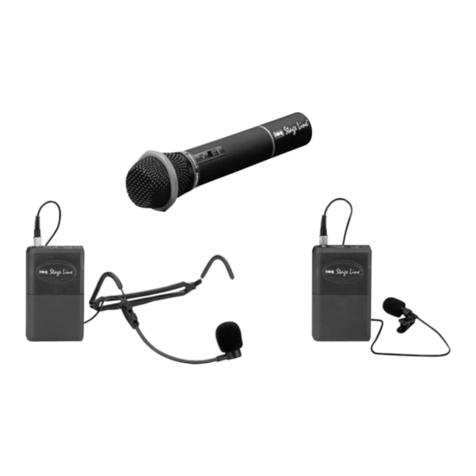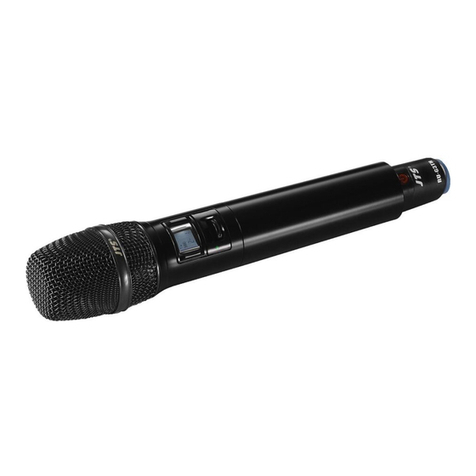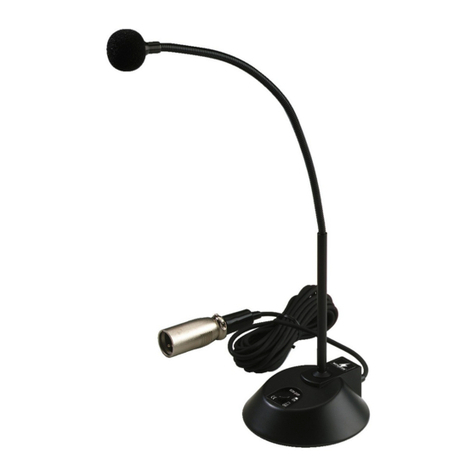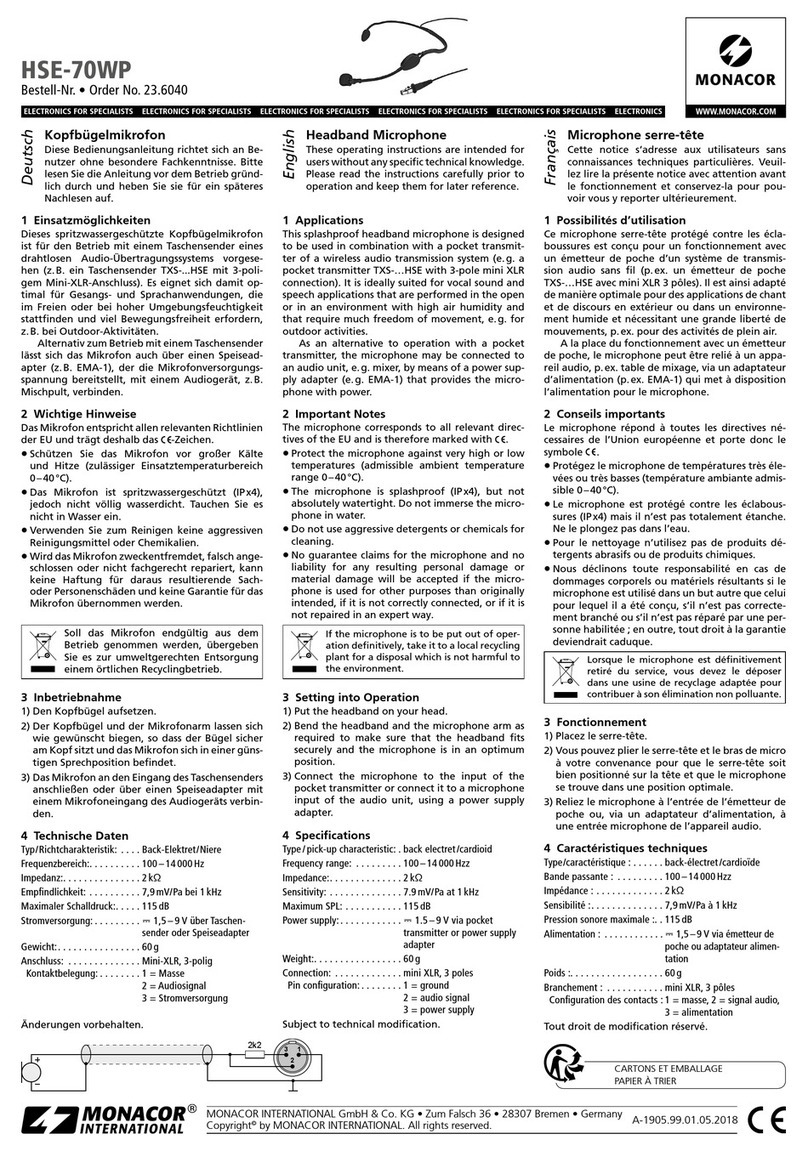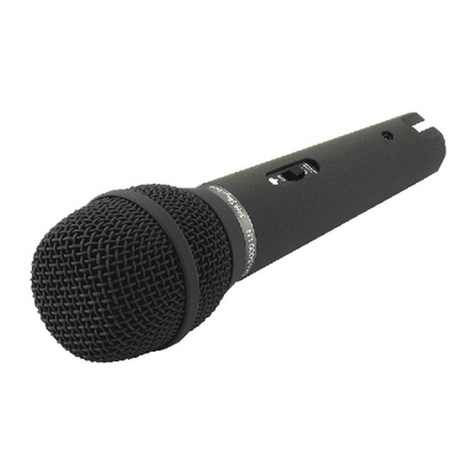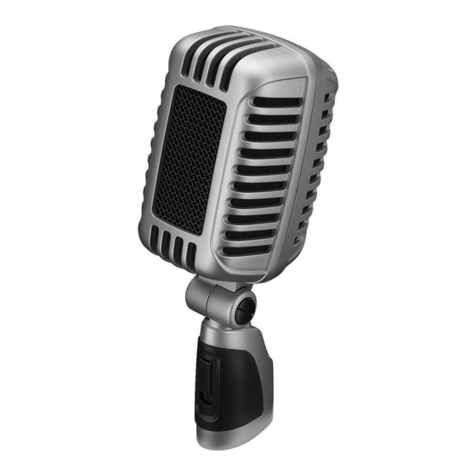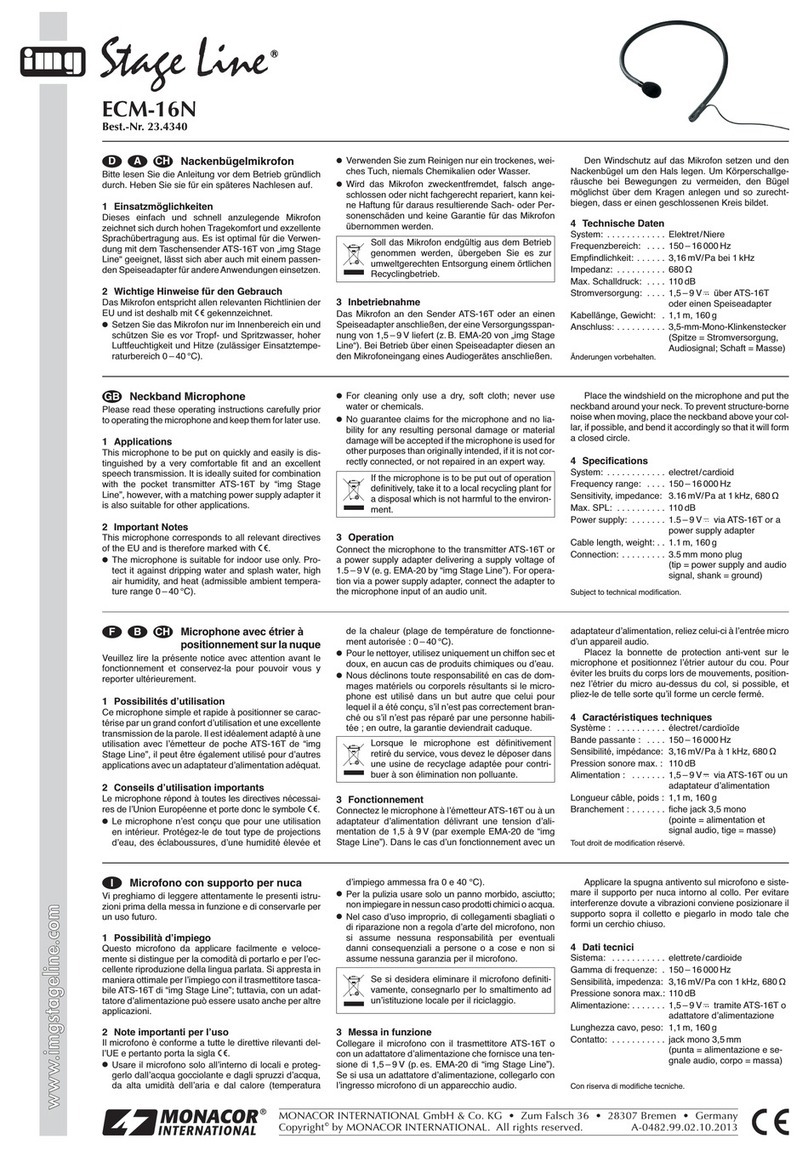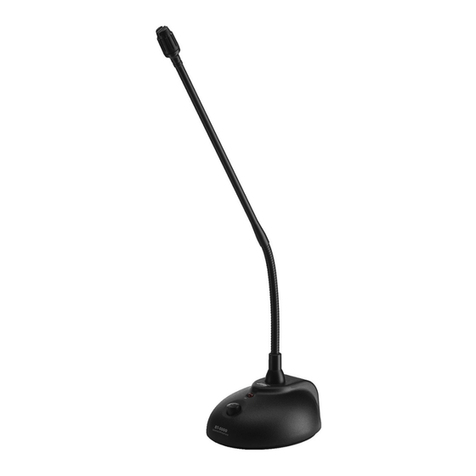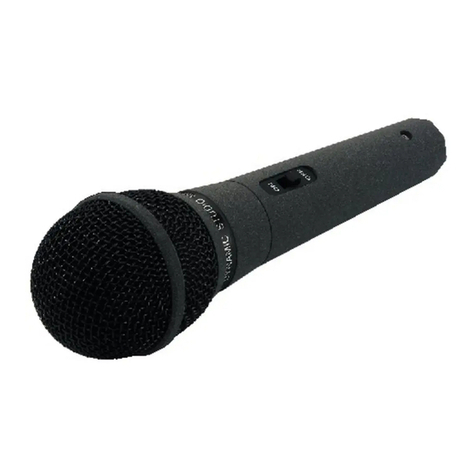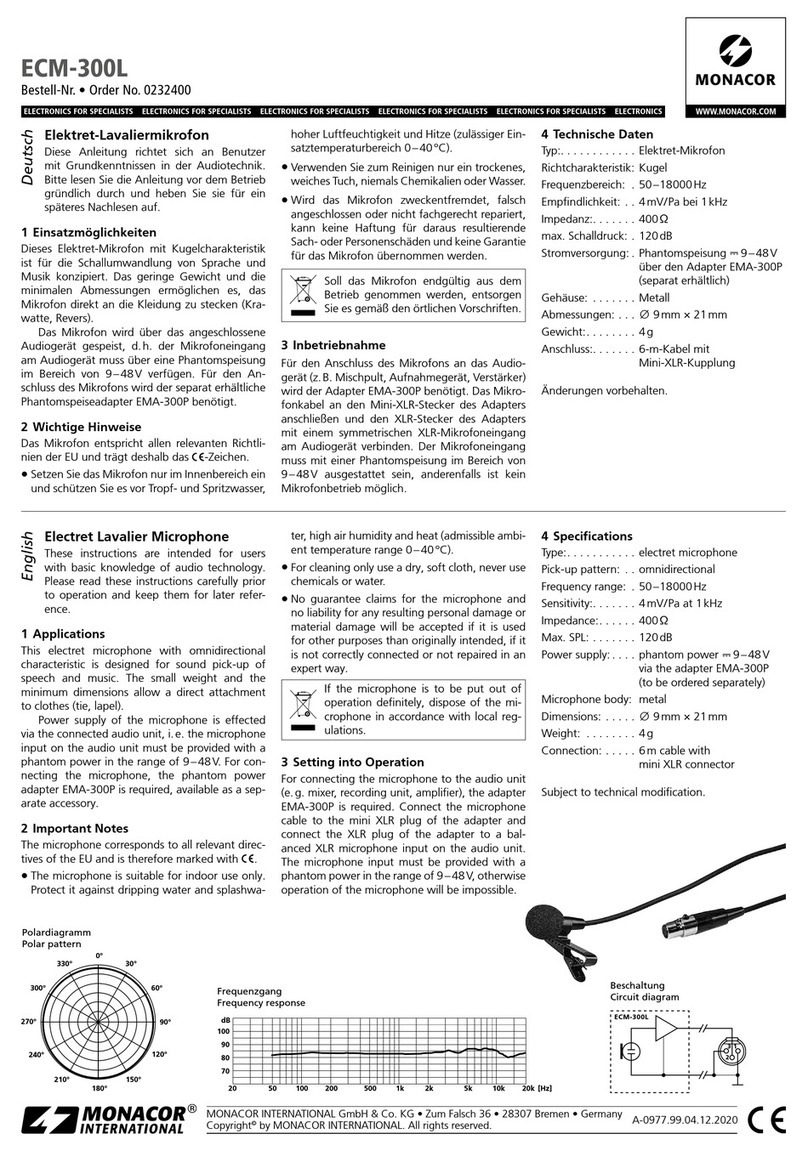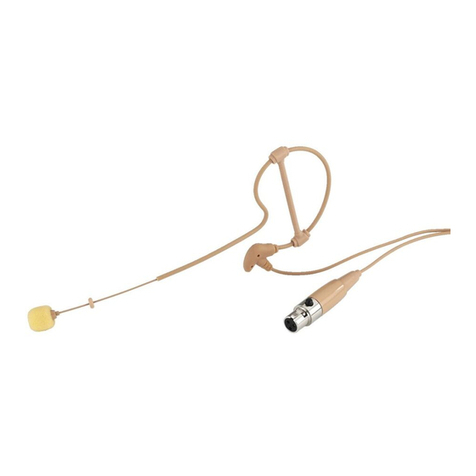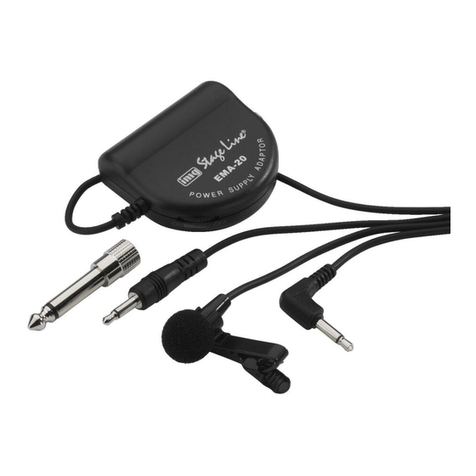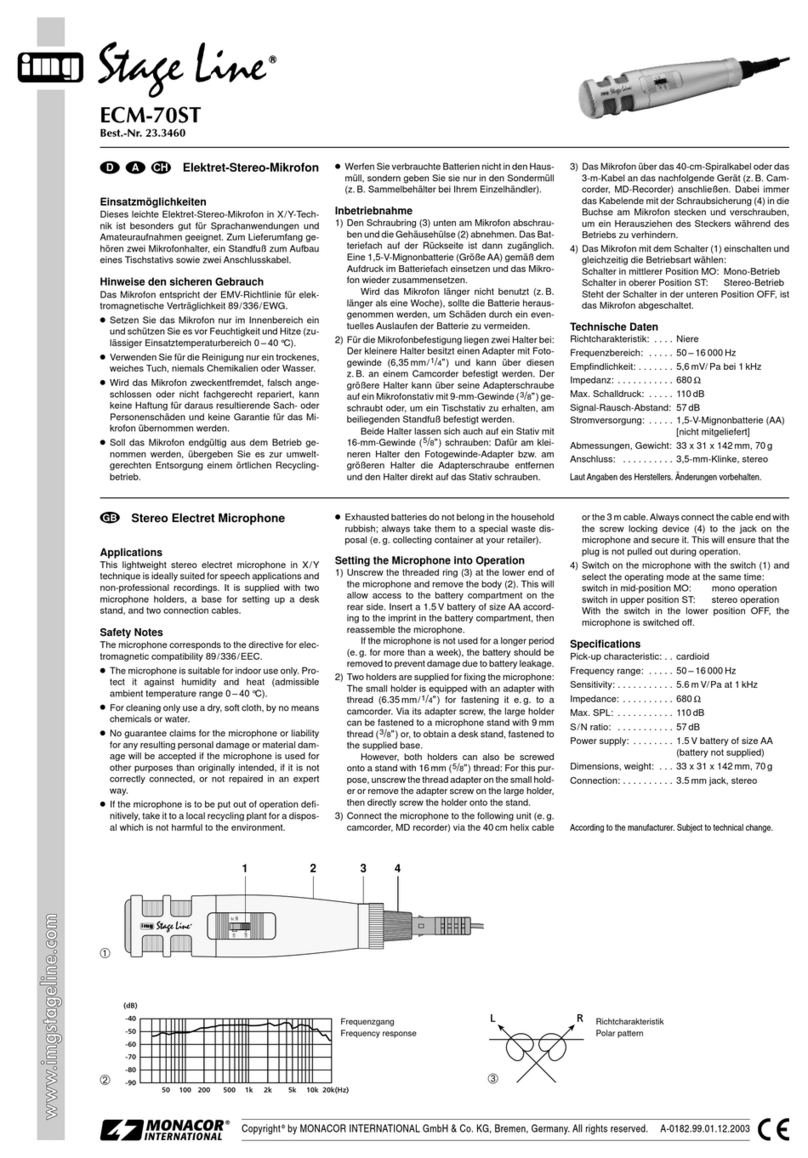Elektret-Richtmikrofon
Bitte lesen Sie die Bedienungsanleitung vor dem
Betrieb gründlich durch und heben Sie sie für ein
späteres Nachlesen auf.
1 Einsatzmöglichkeiten
Das Mikrofon ECM-925P mit umschaltbarer Richt-
charakteristik (Niere/Superniere) ist besonders für
Aufnahmen geeignet, bei denen wegen störender
Nebengeräusche eine starke Richtwirkung erfor-
derlich ist. Es wird mit einem Mikrofonhalter, einem
Windschutz und einem 5 m langen Low-Noise-
Kabel geliefert. Die Stromversorgung kann wahl-
weise über eine Phantomspeisung von 9 – 48 V
erfolgen oder über eine 1,5-V-Batterie.
2 Hinweise für den sicheren Gebrauch
Das Mikrofon entspricht allen erforderlichen Richtli-
nien der EU und ist deshalb mit gekennzeichnet.
GSchützen Sie das Mikrofon vor Feuchtigkeit und
Hitze (zulässiger Einsatztemperaturbereich 0 °C
bis 40 °C). Das Mikrofon ist nicht wetterfest. Ach-
ten Sie deshalb bei Außenaufnahmen auf Schutz
vor Regen und sonstigem Niederschlag.
GVerwenden Sie für die Reinigung nur ein trocke-
nes, weiches Tuch, auf keinen Fall Chemikalien
oder Wasser.
GWird das Mikrofon zweckentfremdet, falsch an-
geschlossen oder nicht fachgerecht repariert,
kann keine Haftung für daraus resultierende
Sach- oder Personenschäden und keine Garan-
tie für das Mikrofon übernommen werden.
3 Inbetriebnahme
1) Ist der Mikrofoneingang, an dem das Mikrofon an-
geschlossen werden soll, nicht mit einer Phantom-
speisung von 9 – 48 V ausgestattet, eine 1,5-V-
Batterie vom Typ Mignon (AA) einsetzen. Dazu
am unteren Ende des Mikrofons die Schraubhülse
abschrauben. Die Batterie so herum, wie im Bat-
teriefach aufgedruckt, einsetzen.
Bei längerem Nichtgebrauch (z. B. länger als
eine Woche) sollte die Batterie herausgenommen
werden. So bleibt das Mikrofon bei einem even-
tuellen Auslaufen der Batterie unbeschädigt.
2) Die beiliegende Halterung auf ein Stativ mit
16-mm-Gewinde (5⁄8″) schrauben, und das Mi-
krofon darauf stecken. Bei Bedarf den beiliegen-
den Windschutz aufstecken.
3) Das Mikrofon über das beiliegende Anschlusska-
bel an den Mikrofoneingang eines Audiogerätes
(z. B. Mischpult, Aufnahmegerät, Verstärker) an-
schließen.
Soll das Mikrofon endgültig aus dem
Betrieb genommen werden, übergeben
Sie es zur umweltgerechten Entsorgung
einem örtlichen Recyclingbetrieb.
Werfen Sie verbrauchte Batterien nicht in den
Hausmüll, sondern geben Sie sie nur in den Son-
dermüll (z. B. Sammelbehälter bei Ihrem Elektro-
fachhändler).
4) Mit dem Schiebeschalter die Richtcharakteristik
auswählen:
NORMAL = Niere, TELE = Superniere
Das Mikrofon ist damit eingeschaltet.
5) Wird das Mikrofon nicht benötigt, den Schiebe-
schalter in die untere Position stellen. Das Mikro-
fon ist damit abgeschaltet.
4 Technische Daten
Frequenzbereich: . . . . . . . . 80 – 12 000 Hz
Empfindlichkeit, Impedanz
Normal (Niere): . . . . . . . . 3 mV/ Pa bei 1 kHz,
1,0 kΩ
Tele (Superniere): . . . . . . 15 mV/ Pa bei 1 kHz,
2,3 kΩ
maximaler Schalldruck: . . . 120 dB
Signal/Rauschabstand: . . . > 40 dB
Stromversorgung: . . . . . . . . Phantomspeisung
9 – 48 V oder
1,5-V-Batterie Typ
Mignon (AA)
Einsatztemperatur: . . . . . . . 0 – 40 °C
Gehäuse: . . . . . . . . . . . . . . Metall
Abmessungen: . . . . . . . . . . ∅25 mm × 285 mm
Gewicht ohne Batterie: . . . . 460 g
Anschluss: . . . . . . . . . . . . . XLR, sym.
Änderungen vorbehalten.
Electret Directional
Microphone
Please read these operating instructions carefully
prior to operation and keep them for later use.
1 Applications
The microphone ECM-925P with switchable pick-up
pattern (cardioid/supercardioid) is especially suit-
able for recordings which require a strong directivity
due to interfering ambient noise. It is supplied with
a microphone support, a windshield, and a 5 m low
noise cable. The power supply can be made alter-
natively via a phantom power of 9 – 48 V or via a
1.5 V battery.
2 Safety Notes
The microphone corresponds to all required direc-
tives of the EU and is therefore marked with .
GProtect the microphone against humidity and heat
(admissible ambient temperature range 0 –40 °C).
The microphone is not weatherproof. Therefore, in
case of outdoor recordings take care that it is pro-
tected against rain and other precipitation.
GFor cleaning only use a dry, soft cloth, by no
means chemicals or water.
GNo guarantee claims for the microphone and no
liability for any resulting personal damage or
material damage will be accepted if the micro-
phone is used for other purposes than originally
intended, if it is not correctly connected or not
repaired in an expert way.
3 Setting into Operation
1) If the microphone input, to which the microphone
is to be connected, is not provided with a phan-
tom power of 9 – 48 V , insert a 1.5 V battery of
size AA. For this purpose screw off the screw
sleeve at the lower end of the microphone. Insert
the battery as printed in the battery compartment.
If the microphone is not used for a longer time
(e. g. more than a week), the battery should be
taken out. Thus, the microphone will not be dam-
aged in case the battery should leak.
2) Screw the supplied support onto a stand with
16 mm thread (5⁄8″), and put the microphone onto
it. If required, place the supplied windshield.
3) Connect the microphone via the supplied cable to
the microphone input of an audio unit (e. g. mixer,
recording unit, amplifier).
If the microphone is to be put out of opera-
tion definitively, take it to a local recycling
plant for a disposal which is not harmful to
the environment.
Do not throw exhausted batteries into the house-
hold rubbish but take them to the special waste
disposal (e. g. collective container at your electri-
cal supply shop).
4) Select the directivity with the sliding switch:
NORMAL = cardioid, TELE = supercardioid
Thus, the microphone is switched on.
5) If the microphone is not used, set the sliding
switch to the lower position. Thus, the micro-
phone is switched off.
4 Specifications
Frequency range: . . . . . . . . 80 – 12 000 Hz
Sensitivity, impedance
normal (cardioid): . . . . . . 3 mV/Pa at 1 kHz,
1.0 kΩ
tele (supercardioid): . . . . 15 mV/Pa at 1 kHz,
2.3 kΩ
Max. sound pressure: . . . . . 120 dB
S/N ratio: . . . . . . . . . . . . . . > 40 dB
Power supply: . . . . . . . . . . . phantom power
9 – 48 V or
1.5 V battery, size AA
Ambient temperature: . . . . . 0 – 40 °C
Housing: . . . . . . . . . . . . . . . metal
Dimensions: . . . . . . . . . . . . ∅25 mm × 285 mm
Weight w/o battery: . . . . . . . 460 g
Connection: . . . . . . . . . . . . XLR, bal.
Subject to technical change.
GB
ECM-925P
Bestell-Nr. 23.1990
www.imgstageline.com
D A CH
Beschaltung
Circuit diagram
®
MONACOR INTERNATIONAL GmbH & Co. KG
•
Zum Falsch 36
•
28307 Bremen
•
Germany
Copyright
©
by MONACOR INTERNATIONAL. All rights reserved. A-0102.99.03.05.2011
Frequenzgang
Frequency response
Richtcharakteristik
Polar pattern
